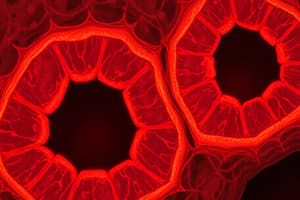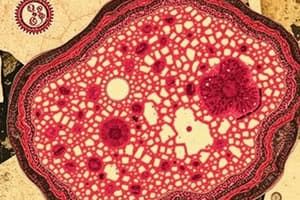Podcast
Questions and Answers
Which intracellular junction allows small molecules to pass between adjacent cells?
Which intracellular junction allows small molecules to pass between adjacent cells?
Gap Junction
Which is not a distinguishing feature of epithelium?
Which is not a distinguishing feature of epithelium?
- Basal surface rests on a basement membrane
- Cells are connected by intracellular junctions
- Contains many blood vessels (correct)
- Contains little or no extracellular matrix between cells
Epithelia can be classified by:
Epithelia can be classified by:
- Number of intracellular junctions
- Number of secretory cells
- Number of cell layers (correct)
- Permeability
Cilia:
Cilia:
Which is NOT a category of epithelial classification?
Which is NOT a category of epithelial classification?
Myelin sheaths in the central nervous system (CNS) are formed by:
Myelin sheaths in the central nervous system (CNS) are formed by:
Which glial cell is capable of becoming phagocytic?
Which glial cell is capable of becoming phagocytic?
Synapse is:
Synapse is:
Which is not a type of glial cell?
Which is not a type of glial cell?
Axons:
Axons:
What is the location of Simple Squamous Epithelium?
What is the location of Simple Squamous Epithelium?
What is the location of Simple Cuboidal Epithelium?
What is the location of Simple Cuboidal Epithelium?
What is the location of Simple Columnar Epithelium?
What is the location of Simple Columnar Epithelium?
What is the location of Pseudostratified Columnar Epithelium with Cilia?
What is the location of Pseudostratified Columnar Epithelium with Cilia?
What is the location of Stratified Squamous Epithelium?
What is the location of Stratified Squamous Epithelium?
What is the location of Transitional Epithelium?
What is the location of Transitional Epithelium?
What is the location of Areolar Connective Tissue?
What is the location of Areolar Connective Tissue?
What is the location of Adipose Connective Tissue?
What is the location of Adipose Connective Tissue?
What is the location of Reticular Connective Tissue?
What is the location of Reticular Connective Tissue?
What is the location of Dense Regular Connective Tissue?
What is the location of Dense Regular Connective Tissue?
What is the location of Dense Irregular Connective Tissue?
What is the location of Dense Irregular Connective Tissue?
What is the location of Hyalin Cartilage Connective Tissue?
What is the location of Hyalin Cartilage Connective Tissue?
What is the location of Fibrocartilage Connective Tissue?
What is the location of Fibrocartilage Connective Tissue?
What is the location of Elastic Cartilage Connective Tissue?
What is the location of Elastic Cartilage Connective Tissue?
What is the location of Compact Bone Connective Tissue?
What is the location of Compact Bone Connective Tissue?
What is the location of Blood Connective Tissue?
What is the location of Blood Connective Tissue?
What is the location of Smooth Muscle Tissue?
What is the location of Smooth Muscle Tissue?
What is the location of Skeletal Muscle Tissue?
What is the location of Skeletal Muscle Tissue?
What is the location of Cardiac Muscle Tissue?
What is the location of Cardiac Muscle Tissue?
What is the location of Nervous Muscle Tissue?
What is the location of Nervous Muscle Tissue?
What is the human scalp?
What is the human scalp?
What are Merocrine Sweat Glands?
What are Merocrine Sweat Glands?
What are Sebaceous Sweat Glands?
What are Sebaceous Sweat Glands?
What is the location of the hair follicle opening?
What is the location of the hair follicle opening?
What is the epidermis?
What is the epidermis?
What is the dermis?
What is the dermis?
What is the hypodermis?
What is the hypodermis?
How do the cells of the stratum corneum and stratum basale differ?
How do the cells of the stratum corneum and stratum basale differ?
State the specific location of melanin observed in dark skin.
State the specific location of melanin observed in dark skin.
Which is darker, the anterior or posterior forearm? Why?
Which is darker, the anterior or posterior forearm? Why?
What special qualities, due to the presence of fibers, does the connective tissue of the dermis have?
What special qualities, due to the presence of fibers, does the connective tissue of the dermis have?
How is the structure of the thick skin of the palms of the hands and soles of the feet properly suited for its function?
How is the structure of the thick skin of the palms of the hands and soles of the feet properly suited for its function?
What part of the hair extends from the hair papilla to the body surface?
What part of the hair extends from the hair papilla to the body surface?
In which layer of the skin are the sebaceous glands found?
In which layer of the skin are the sebaceous glands found?
How are sebaceous glands associated with hair follicles, and what do they secrete?
How are sebaceous glands associated with hair follicles, and what do they secrete?
The ducts of the apocrine sweat glands open into:
The ducts of the apocrine sweat glands open into:
Which type of sweat gland is most important in maintaining normal body temperature?
Which type of sweat gland is most important in maintaining normal body temperature?
Flashcards are hidden until you start studying
Study Notes
Intracellular Junctions and Epithelial Tissue
- Gap junctions allow small molecules to pass between adjacent cells.
- Epithelial tissue does not contain blood vessels, distinguishing it from other tissue types.
- Epithelia classification is based on the number of cell layers.
Cilia and Epithelial Characteristics
- Cilia are motile cell processes aiding in movement.
- Keratinized simple columnar is not a recognized category of epithelial classification.
Nervous Tissue Components
- Myelin sheaths in the CNS are formed by oligodendrocytes.
- Microglia are glial cells capable of phagocytosis.
- Synapses facilitate information transfer from neurons to other cells.
Glial Cell Types
- Endothelial cells are not classified as glial cells.
- Typical axons have a single branch extending from neuron cell bodies.
Types of Epithelial Tissue
- Simple squamous epithelium: Located in the lungs.
- Simple cuboidal epithelium: Found in the kidneys.
- Simple columnar epithelium: Present in the intestines.
- Pseudostratified columnar epithelium with cilia: Located in respiratory passages.
- Stratified squamous epithelium: Found in the vagina.
- Transitional epithelium: Present in urinary bladder linings.
Types of Connective Tissue
- Areolar connective tissue: Surrounds body organs.
- Adipose connective tissue: Found in the breasts.
- Reticular connective tissue: Located in the spleen.
- Dense regular connective tissue: Present in tendons.
- Dense irregular connective tissue: Found in the dermis.
- Hyalin cartilage: Comprises fetal skeleton.
- Fibrocartilage: Found between vertebrae.
- Elastic cartilage: Present in the outer ear.
- Compact bone: Located in bone shafts.
- Blood connective tissue: Found in heart chambers.
Muscle Tissue Types
- Smooth muscle tissue: Located in the small intestine.
- Skeletal muscle tissue: Attached to bones.
- Cardiac muscle tissue: Found in heart walls.
- Nervous tissue: Located in the brain.
Skin Layers and Glands
- Merocrine sweat glands respond to elevated body temperatures, abundant on the forehead, palms, and soles.
- Sebaceous glands secrete sebum, helping to keep skin pliable and are associated with hair follicles.
- The epidermis consists of keratinized stratified squamous epithelium, forming a waterproof barrier.
- The dermis contains areolar and dense irregular connective tissues, housing hair follicles and sweat glands.
- The hypodermis is beneath the skin, comprised of adipose and areolar connective tissues for fat padding.
Skin and Hair Characteristics
- Stratum corneum has multiple layers of dead squamous cells, while stratum basale contains cuboidal living cells.
- Melanin is primarily observed in the stratum basale, contributing to skin color variations.
- The posterior forearm has darker pigmentation due to higher melanin content.
- The thick skin on palms and soles has structures protecting against wear through skin ligaments and the stratum lucidum.
- The hair root extends from the hair papilla to the body surface and sebaceous glands are located in the dermis, secreting sebum into hair follicles.
Sweat Gland Functions
- The ducts of apocrine sweat glands open into dermal papillae.
- Merocrine sweat glands are essential for temperature regulation.
Studying That Suits You
Use AI to generate personalized quizzes and flashcards to suit your learning preferences.




